Rainwater Harvesting System Design Report: Residential Building
VerifiedAdded on 2023/03/21
|17
|2268
|34
Report
AI Summary
This report presents a detailed design for a rainwater harvesting system intended for use in a residential building. The executive summary highlights the pressing need for water conservation, particularly in urban settings, and the potential of rainwater harvesting to supplement water needs. The introduction emphasizes the significance of water, its scarcity, and the benefits of rainwater harvesting. The project objective is to design an efficient and sustainable system to mitigate operational risks and reduce costs. The report details the design process, including water usage patterns, the components of the system, and a process flow diagram. An inventory analysis is conducted to assess material, energy, and emission requirements, alongside quality data assessment and cut-off criteria to ensure system efficiency. The report also features process flow diagrams, data collection tables, and quality data assessments, culminating in a conclusion that stresses the importance of quality assessment and future research to refine rainwater harvesting methods. The appendices include control centers for rainwater harvest and schematic showing water flow from the tank storage to their end use in the different floors of the building.
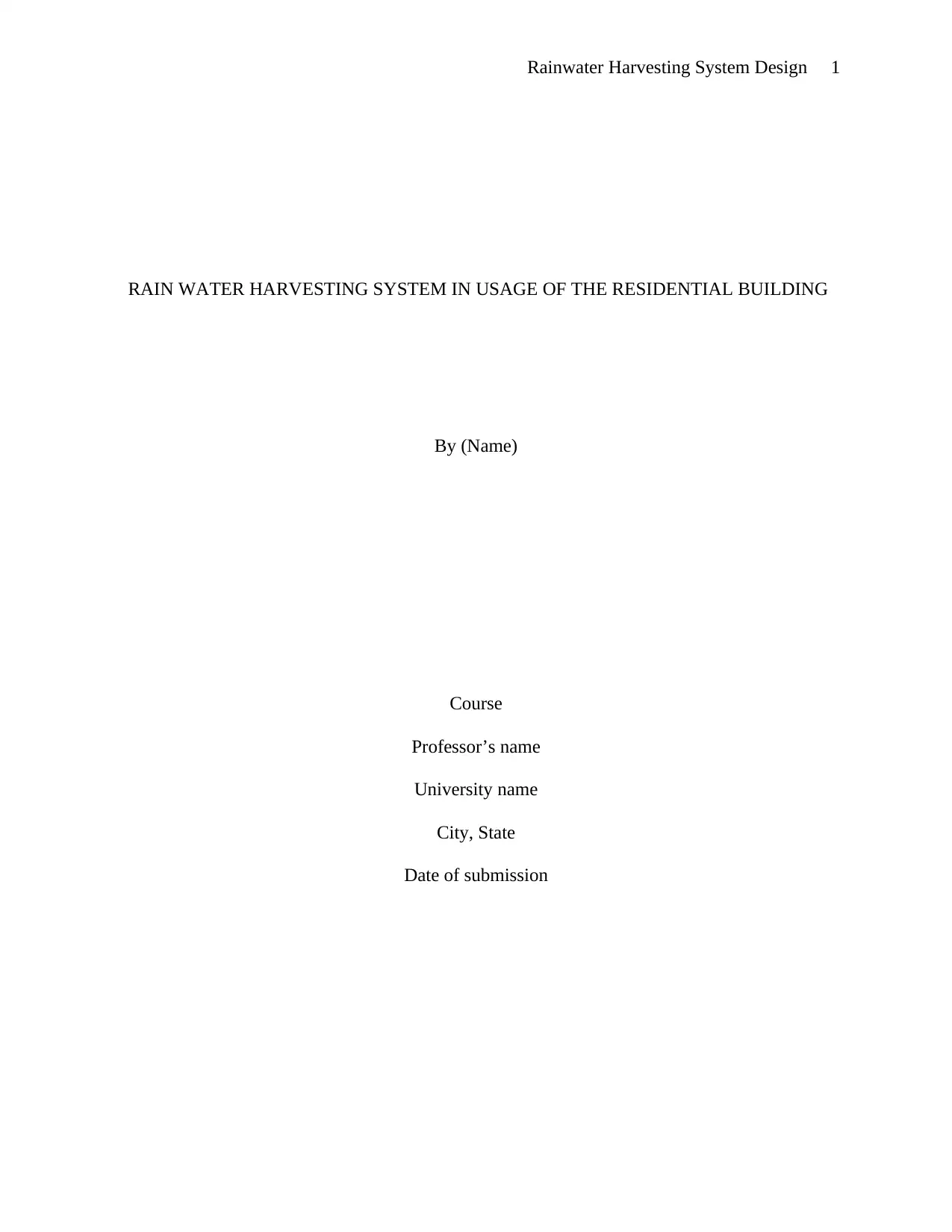
Rainwater Harvesting System Design 1
RAIN WATER HARVESTING SYSTEM IN USAGE OF THE RESIDENTIAL BUILDING
By (Name)
Course
Professor’s name
University name
City, State
Date of submission
RAIN WATER HARVESTING SYSTEM IN USAGE OF THE RESIDENTIAL BUILDING
By (Name)
Course
Professor’s name
University name
City, State
Date of submission
Paraphrase This Document
Need a fresh take? Get an instant paraphrase of this document with our AI Paraphraser
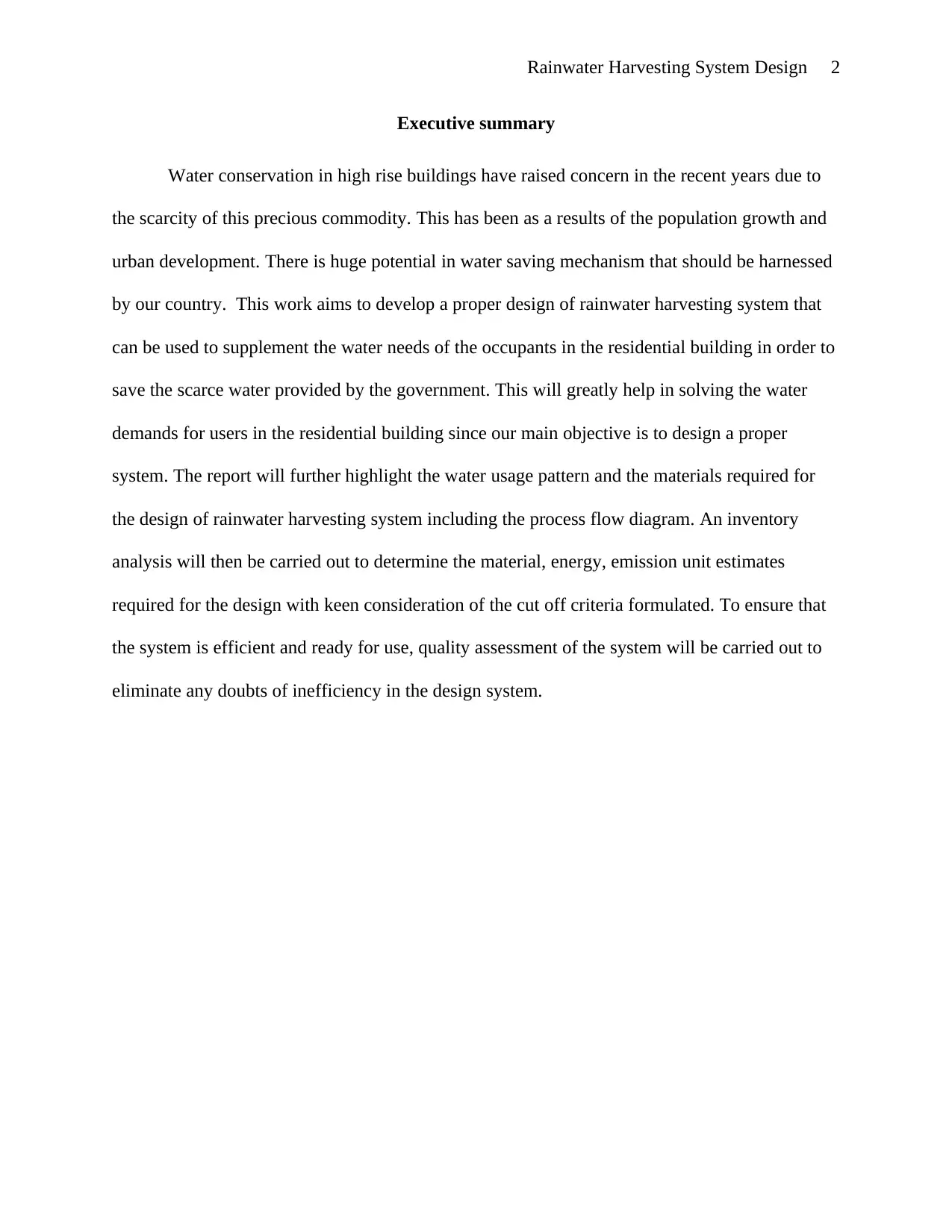
Rainwater Harvesting System Design 2
Executive summary
Water conservation in high rise buildings have raised concern in the recent years due to
the scarcity of this precious commodity. This has been as a results of the population growth and
urban development. There is huge potential in water saving mechanism that should be harnessed
by our country. This work aims to develop a proper design of rainwater harvesting system that
can be used to supplement the water needs of the occupants in the residential building in order to
save the scarce water provided by the government. This will greatly help in solving the water
demands for users in the residential building since our main objective is to design a proper
system. The report will further highlight the water usage pattern and the materials required for
the design of rainwater harvesting system including the process flow diagram. An inventory
analysis will then be carried out to determine the material, energy, emission unit estimates
required for the design with keen consideration of the cut off criteria formulated. To ensure that
the system is efficient and ready for use, quality assessment of the system will be carried out to
eliminate any doubts of inefficiency in the design system.
Executive summary
Water conservation in high rise buildings have raised concern in the recent years due to
the scarcity of this precious commodity. This has been as a results of the population growth and
urban development. There is huge potential in water saving mechanism that should be harnessed
by our country. This work aims to develop a proper design of rainwater harvesting system that
can be used to supplement the water needs of the occupants in the residential building in order to
save the scarce water provided by the government. This will greatly help in solving the water
demands for users in the residential building since our main objective is to design a proper
system. The report will further highlight the water usage pattern and the materials required for
the design of rainwater harvesting system including the process flow diagram. An inventory
analysis will then be carried out to determine the material, energy, emission unit estimates
required for the design with keen consideration of the cut off criteria formulated. To ensure that
the system is efficient and ready for use, quality assessment of the system will be carried out to
eliminate any doubts of inefficiency in the design system.
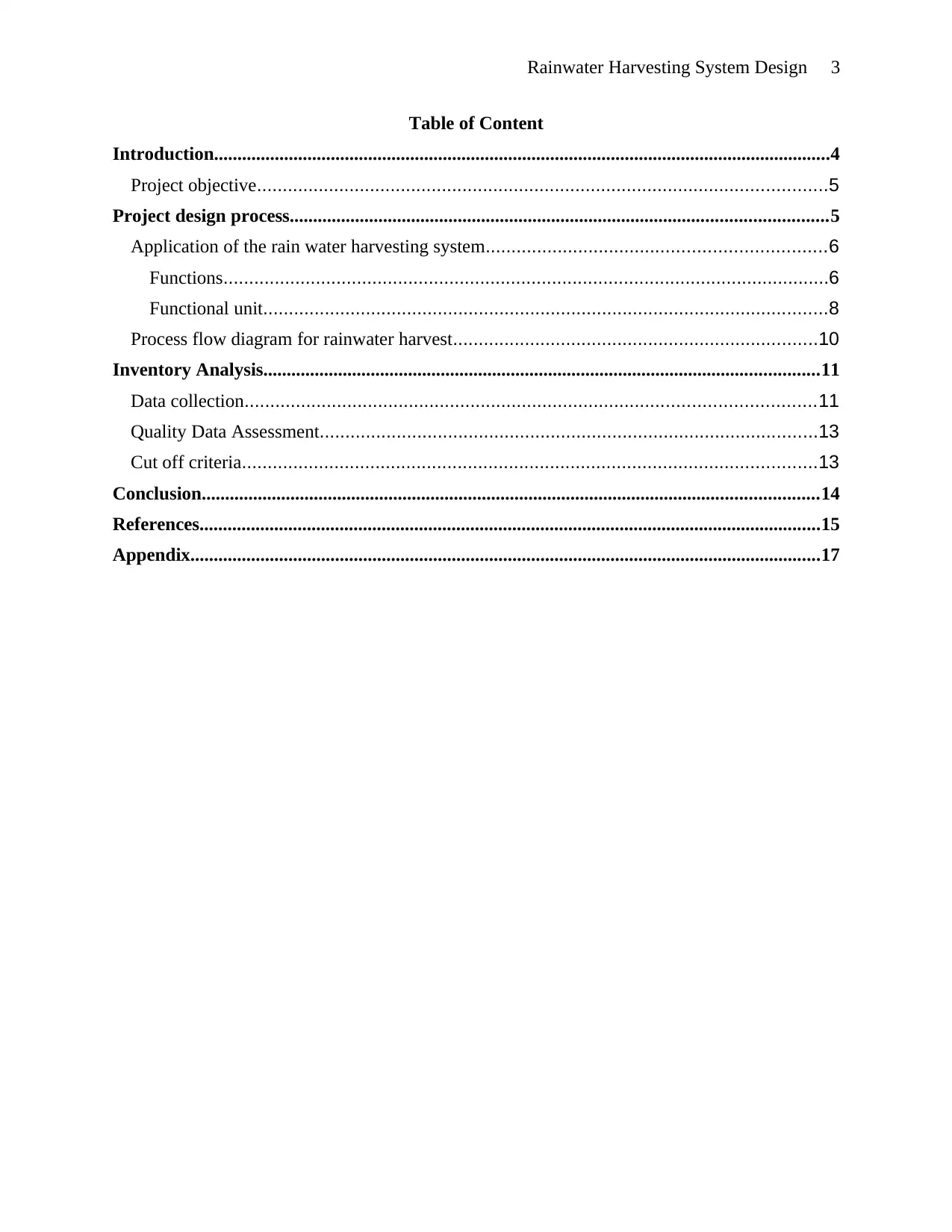
Rainwater Harvesting System Design 3
Table of Content
Introduction....................................................................................................................................4
Project objective...............................................................................................................5
Project design process...................................................................................................................5
Application of the rain water harvesting system..................................................................6
Functions......................................................................................................................6
Functional unit..............................................................................................................8
Process flow diagram for rainwater harvest.......................................................................10
Inventory Analysis.......................................................................................................................11
Data collection...............................................................................................................11
Quality Data Assessment.................................................................................................13
Cut off criteria................................................................................................................13
Conclusion....................................................................................................................................14
References.....................................................................................................................................15
Appendix.......................................................................................................................................17
Table of Content
Introduction....................................................................................................................................4
Project objective...............................................................................................................5
Project design process...................................................................................................................5
Application of the rain water harvesting system..................................................................6
Functions......................................................................................................................6
Functional unit..............................................................................................................8
Process flow diagram for rainwater harvest.......................................................................10
Inventory Analysis.......................................................................................................................11
Data collection...............................................................................................................11
Quality Data Assessment.................................................................................................13
Cut off criteria................................................................................................................13
Conclusion....................................................................................................................................14
References.....................................................................................................................................15
Appendix.......................................................................................................................................17
⊘ This is a preview!⊘
Do you want full access?
Subscribe today to unlock all pages.

Trusted by 1+ million students worldwide
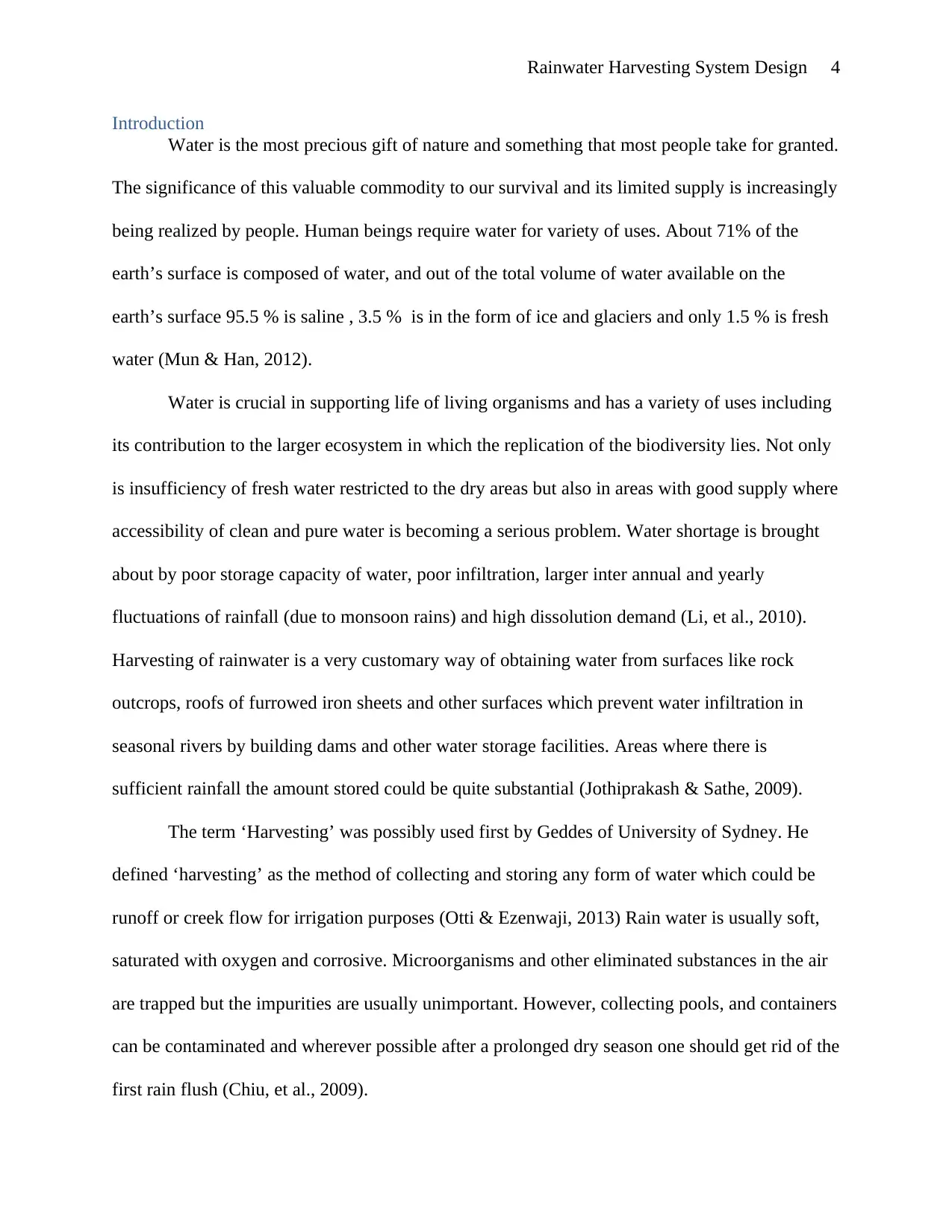
Rainwater Harvesting System Design 4
Introduction
Water is the most precious gift of nature and something that most people take for granted.
The significance of this valuable commodity to our survival and its limited supply is increasingly
being realized by people. Human beings require water for variety of uses. About 71% of the
earth’s surface is composed of water, and out of the total volume of water available on the
earth’s surface 95.5 % is saline , 3.5 % is in the form of ice and glaciers and only 1.5 % is fresh
water (Mun & Han, 2012).
Water is crucial in supporting life of living organisms and has a variety of uses including
its contribution to the larger ecosystem in which the replication of the biodiversity lies. Not only
is insufficiency of fresh water restricted to the dry areas but also in areas with good supply where
accessibility of clean and pure water is becoming a serious problem. Water shortage is brought
about by poor storage capacity of water, poor infiltration, larger inter annual and yearly
fluctuations of rainfall (due to monsoon rains) and high dissolution demand (Li, et al., 2010).
Harvesting of rainwater is a very customary way of obtaining water from surfaces like rock
outcrops, roofs of furrowed iron sheets and other surfaces which prevent water infiltration in
seasonal rivers by building dams and other water storage facilities. Areas where there is
sufficient rainfall the amount stored could be quite substantial (Jothiprakash & Sathe, 2009).
The term ‘Harvesting’ was possibly used first by Geddes of University of Sydney. He
defined ‘harvesting’ as the method of collecting and storing any form of water which could be
runoff or creek flow for irrigation purposes (Otti & Ezenwaji, 2013) Rain water is usually soft,
saturated with oxygen and corrosive. Microorganisms and other eliminated substances in the air
are trapped but the impurities are usually unimportant. However, collecting pools, and containers
can be contaminated and wherever possible after a prolonged dry season one should get rid of the
first rain flush (Chiu, et al., 2009).
Introduction
Water is the most precious gift of nature and something that most people take for granted.
The significance of this valuable commodity to our survival and its limited supply is increasingly
being realized by people. Human beings require water for variety of uses. About 71% of the
earth’s surface is composed of water, and out of the total volume of water available on the
earth’s surface 95.5 % is saline , 3.5 % is in the form of ice and glaciers and only 1.5 % is fresh
water (Mun & Han, 2012).
Water is crucial in supporting life of living organisms and has a variety of uses including
its contribution to the larger ecosystem in which the replication of the biodiversity lies. Not only
is insufficiency of fresh water restricted to the dry areas but also in areas with good supply where
accessibility of clean and pure water is becoming a serious problem. Water shortage is brought
about by poor storage capacity of water, poor infiltration, larger inter annual and yearly
fluctuations of rainfall (due to monsoon rains) and high dissolution demand (Li, et al., 2010).
Harvesting of rainwater is a very customary way of obtaining water from surfaces like rock
outcrops, roofs of furrowed iron sheets and other surfaces which prevent water infiltration in
seasonal rivers by building dams and other water storage facilities. Areas where there is
sufficient rainfall the amount stored could be quite substantial (Jothiprakash & Sathe, 2009).
The term ‘Harvesting’ was possibly used first by Geddes of University of Sydney. He
defined ‘harvesting’ as the method of collecting and storing any form of water which could be
runoff or creek flow for irrigation purposes (Otti & Ezenwaji, 2013) Rain water is usually soft,
saturated with oxygen and corrosive. Microorganisms and other eliminated substances in the air
are trapped but the impurities are usually unimportant. However, collecting pools, and containers
can be contaminated and wherever possible after a prolonged dry season one should get rid of the
first rain flush (Chiu, et al., 2009).
Paraphrase This Document
Need a fresh take? Get an instant paraphrase of this document with our AI Paraphraser
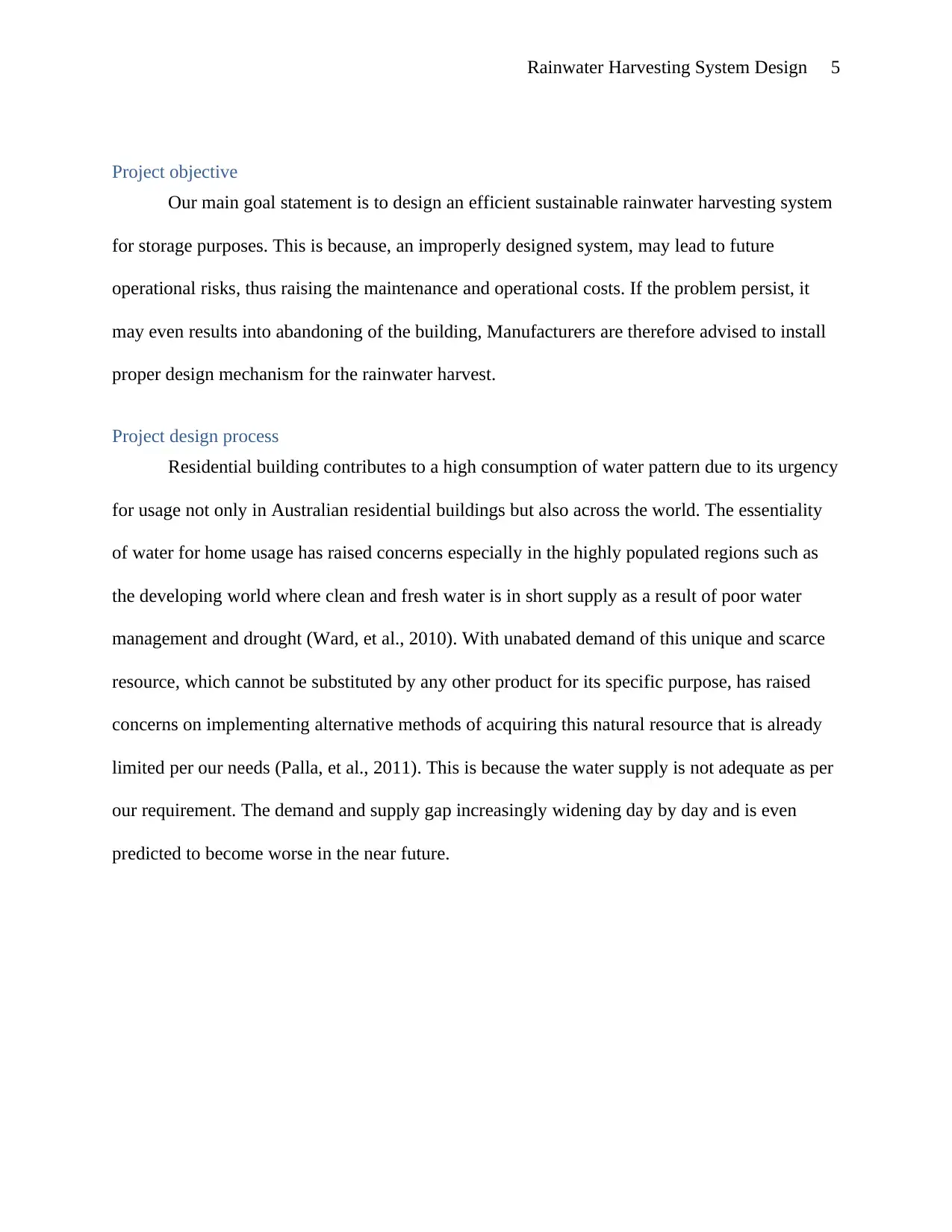
Rainwater Harvesting System Design 5
Project objective
Our main goal statement is to design an efficient sustainable rainwater harvesting system
for storage purposes. This is because, an improperly designed system, may lead to future
operational risks, thus raising the maintenance and operational costs. If the problem persist, it
may even results into abandoning of the building, Manufacturers are therefore advised to install
proper design mechanism for the rainwater harvest.
Project design process
Residential building contributes to a high consumption of water pattern due to its urgency
for usage not only in Australian residential buildings but also across the world. The essentiality
of water for home usage has raised concerns especially in the highly populated regions such as
the developing world where clean and fresh water is in short supply as a result of poor water
management and drought (Ward, et al., 2010). With unabated demand of this unique and scarce
resource, which cannot be substituted by any other product for its specific purpose, has raised
concerns on implementing alternative methods of acquiring this natural resource that is already
limited per our needs (Palla, et al., 2011). This is because the water supply is not adequate as per
our requirement. The demand and supply gap increasingly widening day by day and is even
predicted to become worse in the near future.
Project objective
Our main goal statement is to design an efficient sustainable rainwater harvesting system
for storage purposes. This is because, an improperly designed system, may lead to future
operational risks, thus raising the maintenance and operational costs. If the problem persist, it
may even results into abandoning of the building, Manufacturers are therefore advised to install
proper design mechanism for the rainwater harvest.
Project design process
Residential building contributes to a high consumption of water pattern due to its urgency
for usage not only in Australian residential buildings but also across the world. The essentiality
of water for home usage has raised concerns especially in the highly populated regions such as
the developing world where clean and fresh water is in short supply as a result of poor water
management and drought (Ward, et al., 2010). With unabated demand of this unique and scarce
resource, which cannot be substituted by any other product for its specific purpose, has raised
concerns on implementing alternative methods of acquiring this natural resource that is already
limited per our needs (Palla, et al., 2011). This is because the water supply is not adequate as per
our requirement. The demand and supply gap increasingly widening day by day and is even
predicted to become worse in the near future.
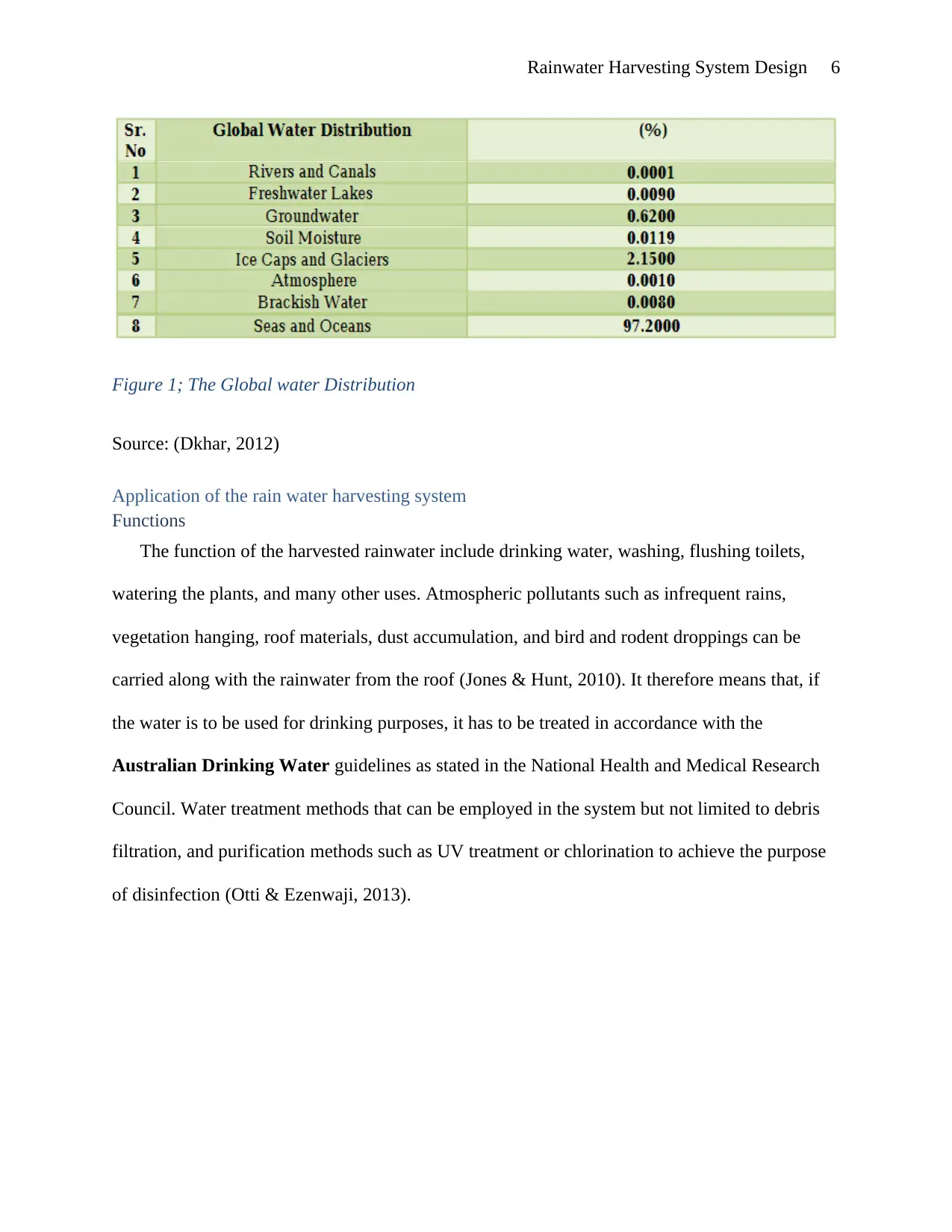
Rainwater Harvesting System Design 6
Figure 1; The Global water Distribution
Source: (Dkhar, 2012)
Application of the rain water harvesting system
Functions
The function of the harvested rainwater include drinking water, washing, flushing toilets,
watering the plants, and many other uses. Atmospheric pollutants such as infrequent rains,
vegetation hanging, roof materials, dust accumulation, and bird and rodent droppings can be
carried along with the rainwater from the roof (Jones & Hunt, 2010). It therefore means that, if
the water is to be used for drinking purposes, it has to be treated in accordance with the
Australian Drinking Water guidelines as stated in the National Health and Medical Research
Council. Water treatment methods that can be employed in the system but not limited to debris
filtration, and purification methods such as UV treatment or chlorination to achieve the purpose
of disinfection (Otti & Ezenwaji, 2013).
Figure 1; The Global water Distribution
Source: (Dkhar, 2012)
Application of the rain water harvesting system
Functions
The function of the harvested rainwater include drinking water, washing, flushing toilets,
watering the plants, and many other uses. Atmospheric pollutants such as infrequent rains,
vegetation hanging, roof materials, dust accumulation, and bird and rodent droppings can be
carried along with the rainwater from the roof (Jones & Hunt, 2010). It therefore means that, if
the water is to be used for drinking purposes, it has to be treated in accordance with the
Australian Drinking Water guidelines as stated in the National Health and Medical Research
Council. Water treatment methods that can be employed in the system but not limited to debris
filtration, and purification methods such as UV treatment or chlorination to achieve the purpose
of disinfection (Otti & Ezenwaji, 2013).
⊘ This is a preview!⊘
Do you want full access?
Subscribe today to unlock all pages.

Trusted by 1+ million students worldwide
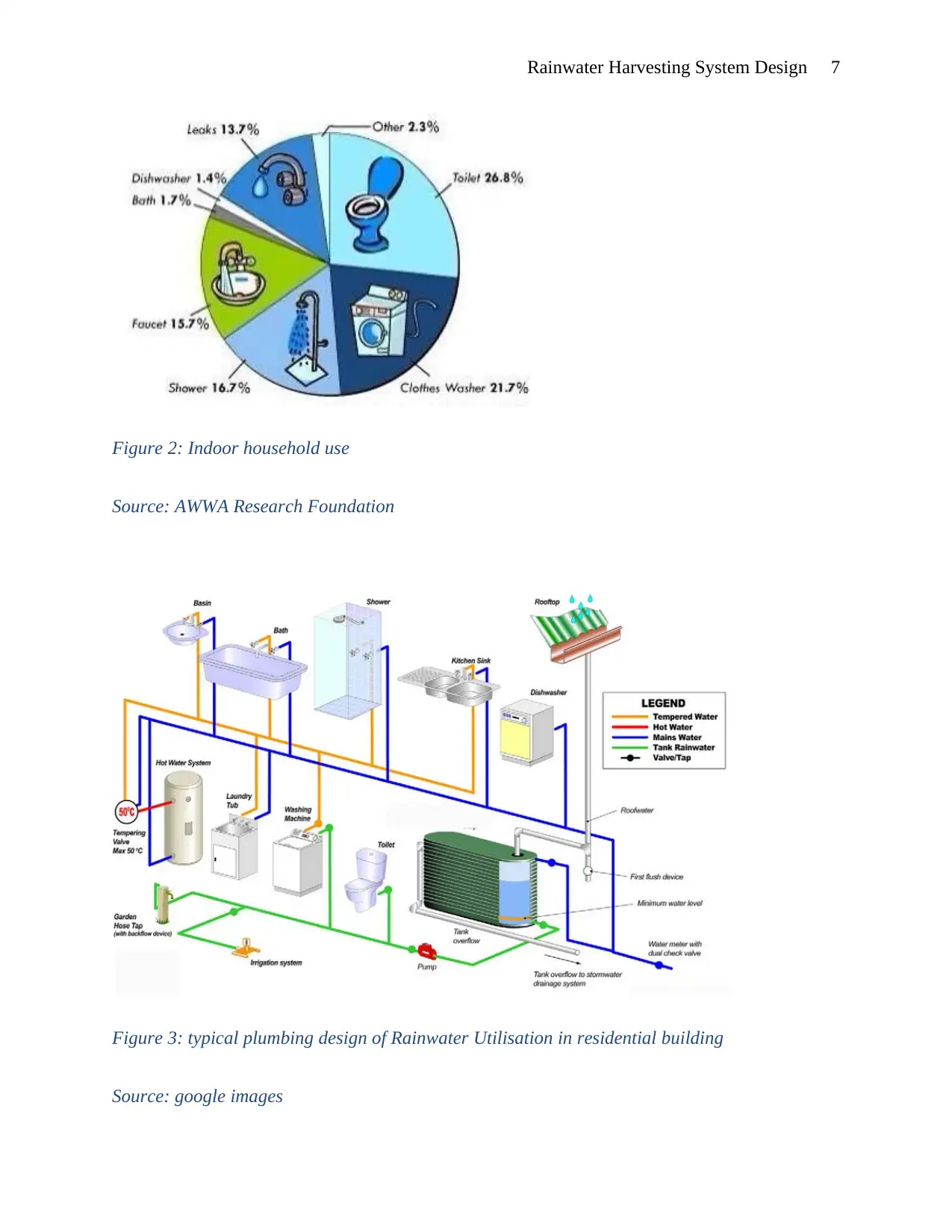
Rainwater Harvesting System Design 7
Figure 2: Indoor household use
Source: AWWA Research Foundation
Figure 3: typical plumbing design of Rainwater Utilisation in residential building
Source: google images
Figure 2: Indoor household use
Source: AWWA Research Foundation
Figure 3: typical plumbing design of Rainwater Utilisation in residential building
Source: google images
Paraphrase This Document
Need a fresh take? Get an instant paraphrase of this document with our AI Paraphraser

Rainwater Harvesting System Design 8
Functional unit
The main components of rain water harvesting system include; conveyance, storage,
overflow, outlet, and delivery. The conveyance system is composed of a series of gutters,
downspouts and downpipes that direct the water collected from the roof to the storage tank or the
cistern. The water harvested will service a four storey residential high rise building. Water will
be supplied to the building from two pipes of 0.5 inch diameter each.
The typical consumption of water in the building is indicated below;
Figure 4: Area of water consumption in the building
Source: (Dkhar, 2012)
Functional unit
The main components of rain water harvesting system include; conveyance, storage,
overflow, outlet, and delivery. The conveyance system is composed of a series of gutters,
downspouts and downpipes that direct the water collected from the roof to the storage tank or the
cistern. The water harvested will service a four storey residential high rise building. Water will
be supplied to the building from two pipes of 0.5 inch diameter each.
The typical consumption of water in the building is indicated below;
Figure 4: Area of water consumption in the building
Source: (Dkhar, 2012)
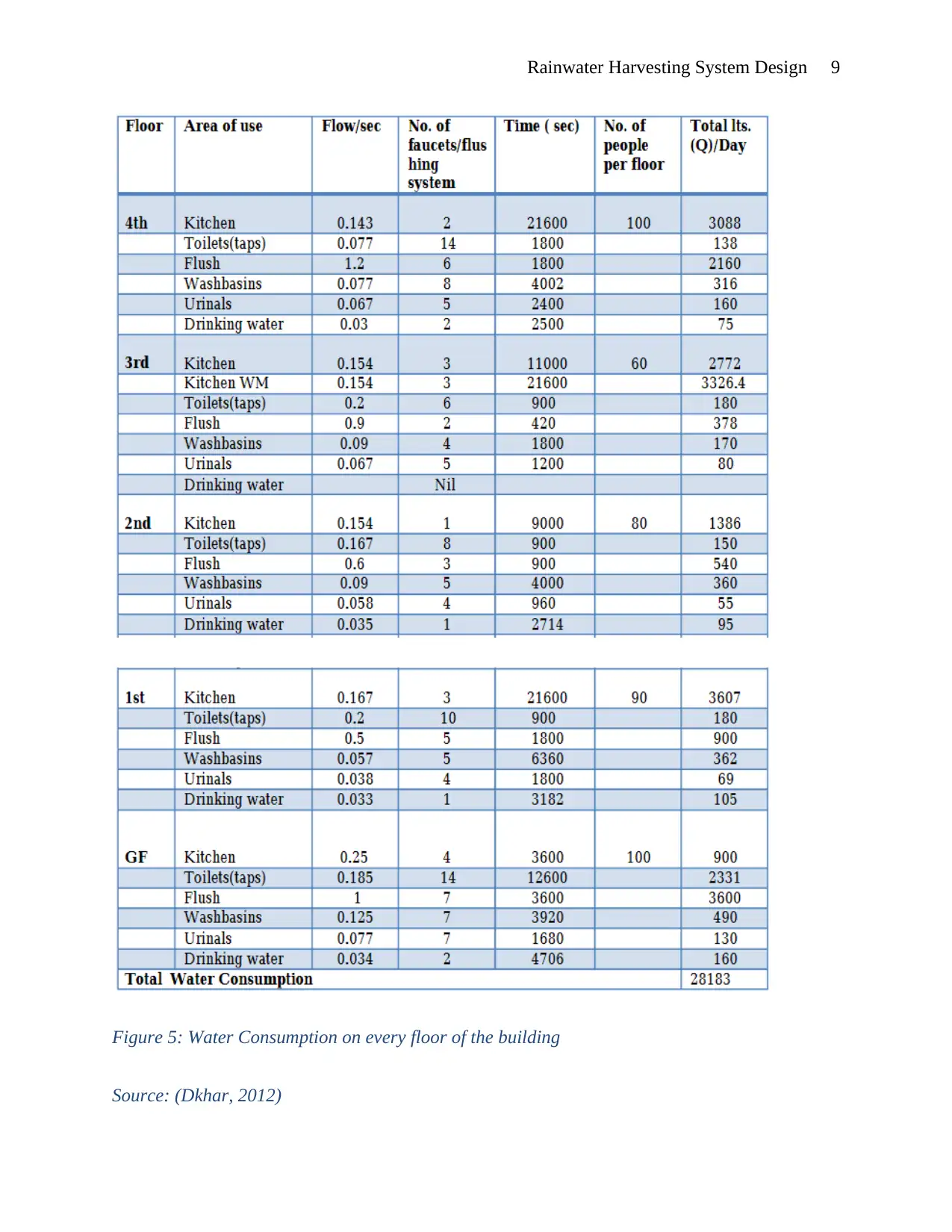
Rainwater Harvesting System Design 9
Figure 5: Water Consumption on every floor of the building
Source: (Dkhar, 2012)
Figure 5: Water Consumption on every floor of the building
Source: (Dkhar, 2012)
⊘ This is a preview!⊘
Do you want full access?
Subscribe today to unlock all pages.

Trusted by 1+ million students worldwide
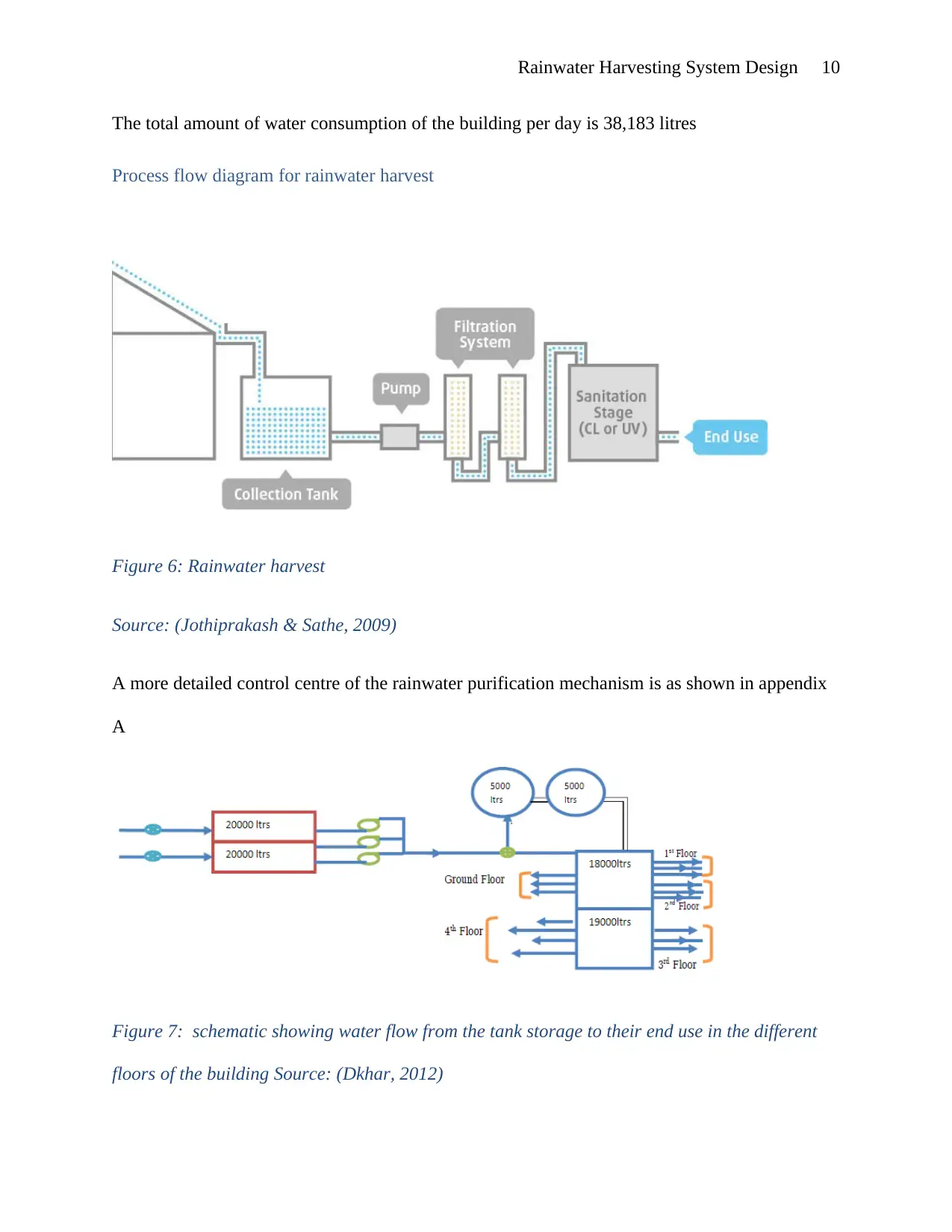
Rainwater Harvesting System Design 10
The total amount of water consumption of the building per day is 38,183 litres
Process flow diagram for rainwater harvest
Figure 6: Rainwater harvest
Source: (Jothiprakash & Sathe, 2009)
A more detailed control centre of the rainwater purification mechanism is as shown in appendix
A
Figure 7: schematic showing water flow from the tank storage to their end use in the different
floors of the building Source: (Dkhar, 2012)
The total amount of water consumption of the building per day is 38,183 litres
Process flow diagram for rainwater harvest
Figure 6: Rainwater harvest
Source: (Jothiprakash & Sathe, 2009)
A more detailed control centre of the rainwater purification mechanism is as shown in appendix
A
Figure 7: schematic showing water flow from the tank storage to their end use in the different
floors of the building Source: (Dkhar, 2012)
Paraphrase This Document
Need a fresh take? Get an instant paraphrase of this document with our AI Paraphraser

Rainwater Harvesting System Design 11
Inventory Analysis
Data collection
Rainwater harvesting in residential buildings
Input Material category Unit Quantity
Acid rain water Elementary flow gallons
Roofing material e.g. sheet, tile or
shingle roof
Elementary flow foot
Gutters Elementary flow foot
Storage tank Elementary flow gallons
All necessary pipes and fittings Elementary flow inches
Cartridge filter Elementary flow Inch
Reverse osmosis filter Elementary flow Inch
UV light disinfection Intermediate product g
Ozone disinfection Intermediate product g
Chlorine disinfection Intermediate product g
Floating filter intake Elementary flow Inch
Pump controller Elementary flow Inch
Fuel Intermediate product Kg
Oxygen Intermediate product Kg
Overflow siphon Elementary flow Inch
First flush diverter Elementary flow Inch
Down spout debris diverter Elementary flow Inch
Valves Elementary flow Inch
Inventory Analysis
Data collection
Rainwater harvesting in residential buildings
Input Material category Unit Quantity
Acid rain water Elementary flow gallons
Roofing material e.g. sheet, tile or
shingle roof
Elementary flow foot
Gutters Elementary flow foot
Storage tank Elementary flow gallons
All necessary pipes and fittings Elementary flow inches
Cartridge filter Elementary flow Inch
Reverse osmosis filter Elementary flow Inch
UV light disinfection Intermediate product g
Ozone disinfection Intermediate product g
Chlorine disinfection Intermediate product g
Floating filter intake Elementary flow Inch
Pump controller Elementary flow Inch
Fuel Intermediate product Kg
Oxygen Intermediate product Kg
Overflow siphon Elementary flow Inch
First flush diverter Elementary flow Inch
Down spout debris diverter Elementary flow Inch
Valves Elementary flow Inch
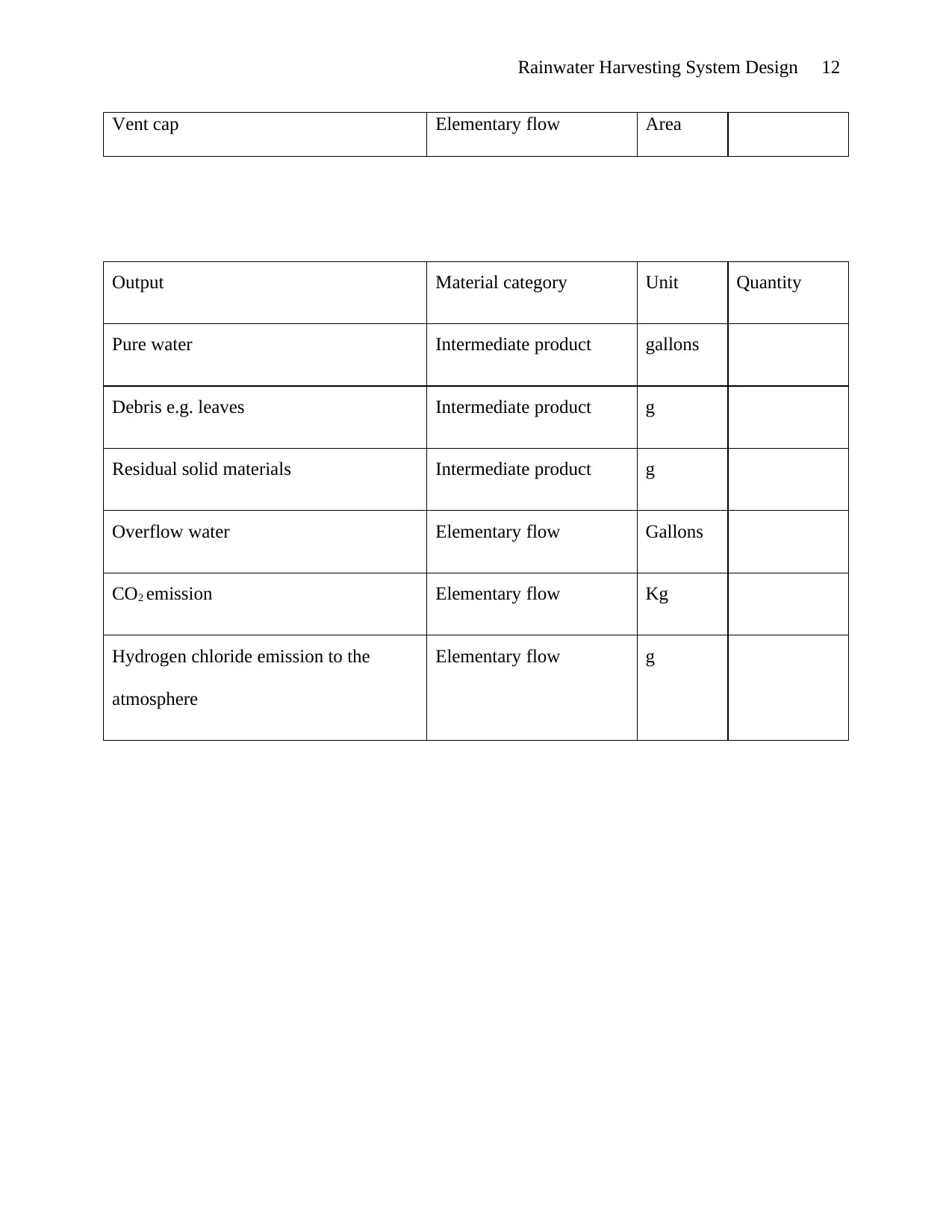
Rainwater Harvesting System Design 12
Vent cap Elementary flow Area
Output Material category Unit Quantity
Pure water Intermediate product gallons
Debris e.g. leaves Intermediate product g
Residual solid materials Intermediate product g
Overflow water Elementary flow Gallons
CO2 emission Elementary flow Kg
Hydrogen chloride emission to the
atmosphere
Elementary flow g
Vent cap Elementary flow Area
Output Material category Unit Quantity
Pure water Intermediate product gallons
Debris e.g. leaves Intermediate product g
Residual solid materials Intermediate product g
Overflow water Elementary flow Gallons
CO2 emission Elementary flow Kg
Hydrogen chloride emission to the
atmosphere
Elementary flow g
⊘ This is a preview!⊘
Do you want full access?
Subscribe today to unlock all pages.

Trusted by 1+ million students worldwide
1 out of 17
Your All-in-One AI-Powered Toolkit for Academic Success.
+13062052269
info@desklib.com
Available 24*7 on WhatsApp / Email
![[object Object]](/_next/static/media/star-bottom.7253800d.svg)
Unlock your academic potential
Copyright © 2020–2025 A2Z Services. All Rights Reserved. Developed and managed by ZUCOL.